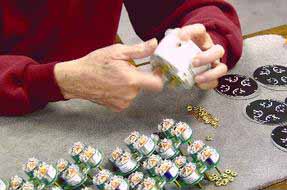.jpg)
Mechanical vs. Electrical Gauges
One of the first decisions Classic Instruments™ made as a new company in 1977 was whether to continue the time-honored tradition of building mechanical gauge movements or step forward into the world of electronics.
Classic Instruments™ made that decision by determining to utilize the very latest technology in computer chips, servo motors, solenoids, remote sensors, and all the other components that are common-place today!
To make that decision was difficult in one respect. How do we convince generations of hot rodders and car-builders that electronics were the way to go? The first challenge to unravel was--just how did mechanical gauges get the reputation for accuracy and durability that they enjoyed?

1) Mechanicals had been the "only game in town" for decades, and . . .
2) Mechanicals were used by the competitive race car drivers and owners, and . . .
3) The perception was that mechanical gauges were more accurate than electrical instruments! This translated, at least for Classic, that "Yes-mechanicals had been the only game it town", and "Yes-they were being used by the best race drivers out there", and "Yes-they did appear to be more accurate than the electrical instruments that were available!"
"The only game in town" was true until the technology and know-how in remote electrical sensing became available and affordable, as it did in the 1970's!
"The race drivers and mechanics all used mechanicals." This is another true statement because quality electricals were not yet available, and because most race cars didn't even carry a battery. Remember the over-sized external rotary starters the pit-crews used to shove into the noses of the cars to get them started--and the magnetoes that were used instead of a "battery-powered" ignition system!
"Yes, mechanicals did appear to be more accurate," another true statement at the time! Since the mid 1970's, gains in electronic technology, component costs, and assembly methods have made electronic instruments available at a reasonable price and with an accuracy and reliability that rivals even the most expensive mechanical units.